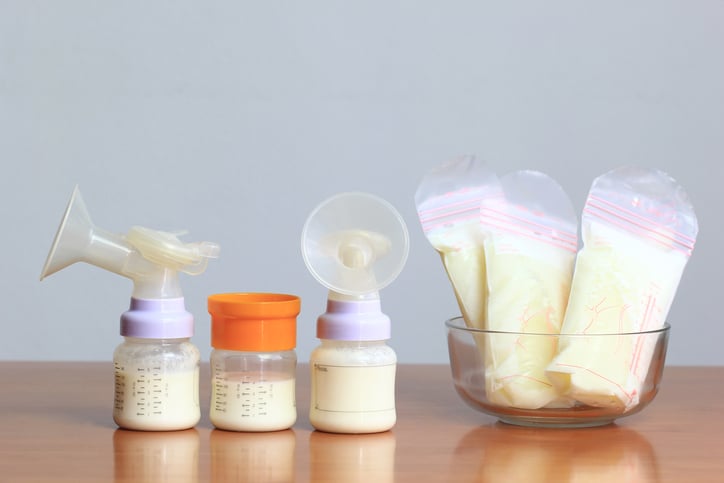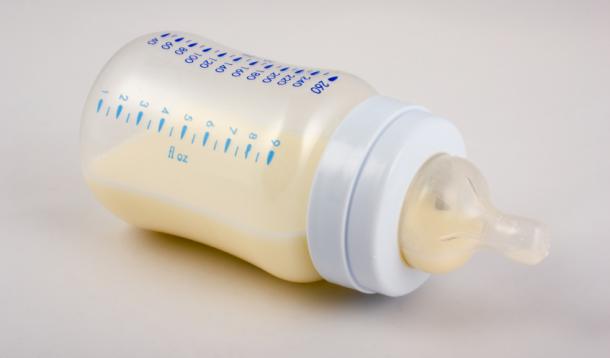Transitioning back to work after having a baby can be tricky, especially for breastfeeding moms who wish to continue nursing. There are so many questions! How can I keep my milk supply up? Can I pump?

If you’re anything like me, you may have some anxiety about how it’s all going to work; keeping your milk supply up, making sure that you have the time and a comfortable space to pump at work, and finding the right childcare situation where your wish to continue breastfeeding is supported.
When my third baby was six-months-old, I decided to return to work (I’m self-employed and didn’t have a maternity leave–here in Canada, most women have a year-long maternity leave), and leave my three kids with our part-time nanny at the time. Luckily, she was very supportive of my desire to continue nursing, and handled and stored my pumped milk with care. I had also sourced out a room at my workplace that I could pump in, which allowed me to keep my supply up and continue to offer my baby breastmilk during the day when I wasn’t at home. It wasn’t a walk in the park though–it took time, perseverance, and dedication to continue breastfeeding after returning to work.

Top 8 tips to help nursing mamas make a smooth transition back to work:
Invest in a good pump. You won’t regret it!
If you plan on continuing to offer your baby breastmilk during the day after you return to work, it’s important that you keep your milk supply up by pumping, especially if your baby is still nursing several times a day. Investing in a good pump can help to cut down on pumping time and maximize the milk that you can save. If at all possible, purchase or rent a good quality hands-free electric double pump. If you’re planning to stop during-the-day breastmilk feedings, you’ll still likely need to hand-express during the day if you’re feeling too full at first, so that you don’t become engorged or uncomfortable.
Stay organized
Make sure that all of your pumping supplies are washed and ready in your pumping bag the night before a work day. There’s nothing worse than realizing that you’ve forgotten a crucial part of your pumping gear when you go to do your morning pump. Make sure that you have your lunch, snacks and water packed the night before as well ( if you’re like me, you’ll want to reserve time in the morning for a good nursing session). Carve out time in your work day to pump (ideally so that it coincides with when your baby drinks a bottle of pumped breastmilk at home or daycare). Set it is a “meeting” in your calendar so that you remember and other tasks don’t take over.
Prior to returning to work, talk to your employer about how often you will need to pump and explain the importance of timing as well. Some employers are more flexible than others, but hopefully you can come of a compromise that suits everyone.

Pump when your baby eats
Although milk supply will vary drastically from mom to mom, most will need to pump two to three times during the work day to keep their milk supply up. As your baby gets older and eats more solid foods, the frequency in which you’ll need to pump will decrease. It also helps to pump at around the same time that your baby feeds, so that you stay on schedule for when you return home from work (so that baby is ready to nurse when you arrive home).
When I first returned to work, I had my nanny text me when she was about to start feeding my baby a bottle, so that I could pump around the same time. This worked well for me, both because I’m self-employed and have a nanny. A friend of mine, who works at a large corporation and cannot always slip away to pump on short notice, would schedule two to three (depending on how often her baby was feeding) daily “meetings” for herself where she would pump in her office with the door closed so that no one would interrupt her.
Have a childcare plan
You’ll want to find childcare that supports your wish to continue breastfeeding, feeds your baby in a responsive way and handles and stores your breastmilk in a safe way. Childcare situations vary greatly; from live-in nannies or grandparents, to large daycares, so it’s important to find the right fit for you and your family. You’ll want to make sure that you practice feeding your baby a bottle of pumped milk prior to heading back to work so that he or she is used to drinking from it.
If you have an older baby (6 months or older) you might choose to skip the bottle and offer breastmilk in a spill-proof straw or sippy cup (or an open cup) during the day instead. If your baby is used to being nursed to sleep at nap time, you can guide your childcare provider on various alternative soothing techniques such as rocking a certain way, offering a pacifier, rubbing baby’s back etc.

Stay hydrated and nourished throughout the day
It’s important to drink plenty of fluids (your fluid requirements increase when you’re nursing) and keep yourself well nourished, eating about every 2-4 hours. If you’re exclusively breastfeeding, you require an extra 300-450 calories per day, depending on how often you’re nursing and how old your baby is. Keeping a water bottle beside you will help to remind you to drink, and packing a healthy lunch (and extra for snacks!) will make it easier to eat healthfully while at work.
Source out a good pumping room
Some workplaces have reserved and comfortable “pumping/feeding rooms” and others aren’t as accommodating to nursing mothers. It’s important to know what your options are–whether it’s your private office, or if it’s a clean private bathroom, or maybe a private boardroom that you can book two to three times per day. Keep in mind that you’ll need to wash your pumping equipment soon after pumping, so being close to a sink is ideal. Let your employer (or your workmates or employees) know that you may be occupying that space two to three times per day (and rough timing) so that everyone is aware.
Keep your your milk safe
If you’re pumping milk at work for your childcare provider to feed your baby at home or at daycare, make sure that you store your milk safely after pumping. Pumped breastmilk can remain at room temperature for 4-8 hours (ideally 3-4), but it’s best to store in a refrigerator between 32-39 °F/0-4 °C. Pumped milk can store in the refrigerator for up to 3-8 days (ideally 3-4). If you don’t have access to a fridge, an alternative is storing your milk in an insulated bag or cooler with ice packs (59°F / 15°C) for up to 24 hours. If you have a long commute home, it’s best to transport your refrigerated milk in a cooler and then transfer to a fridge at home.
Plan to nurse more at night and on weekends
After returning to work, you might notice that your milk supply decreases–even when you’re pumping. If your baby is still nursing often (and you want to continue giving her or him breastmilk several times a day), plan to nurse more frequently at night and on the weekends to build your supply back up. Patience is key here. While some moms won’t notice much of a difference at all in their supply, others do (like me). They’ll need to carve out lots of time to re-establish milk supply during those times that they’re with their babies.

You might also be interested in reading about how to start your baby on solid foods, or My Top Tips for Baby-Led Weaning
Are you thinking that you might want some one-on-one nutrition counselling, either for you, or your baby or child? Check out our one-on-one nutrition counselling services here (you may have benefits that cover our services!)



![[AD] It’s Day 6 of my 15-Minute Supper Series and today we’re putting a delicious twist on a classic BLT to make it nourishing and meal-worthy 🤤
Make sure to comment “Spud” and I’ll send you my top dietitian tips for feeding your family on busy weeknights along with a huge list of meal ideas!
This pasta salad takes no time at all to throw together and has everything you need for a nourishing meal. I always make extra bacon for things like this, but if you don’t have any cooked bacon I find cooking it in the airfryer or stovetop the quickest 🥓
I find that this salad lasts 2-3 days in the fridge without getting too soggy. You can also add in fresh lettuce to crisp it up or add the dressing when you eat it.
I ordered all of my groceries from @spuddelivers, which always saves me time and effort and gives me peace of mind knowing that I’m using high-quality, local and sustainable ingredients. I love that they come straight to my door the day after ordering 🙌🏻
Let’s make it!
Ingredients:
* 10 slices bacon cooked and diced
* 12 ounces pasta cooked and cooled
* 1 cup homemade Ranch dressing
* 1 ½ cup baby tomatoes diced
* ½ avocado diced
* feta
* ⅓ cup red onion diced
* 1 cup romaine lettuce
* fresh parsley for garnish optional
Homemade ranch dressing:
* ¾ cup mayonnaise
* ½ cup sour cream or Greek yogurt
* ½ teaspoon dried chives
* ½ teaspoon dried parsley
* ½ teaspoon dried dill weed
* ¼ teaspoon garlic powder
* ¼ teaspoon onion powder
* Salt and pepper to taste
Make it:
1. Blend all Ranch dressing ingredients together in a small blender (or whisk by hand) and set aside.
2. In a large bowl assemble the pasta, tomatoes, avocado, cheese, red onion, lettuce and bacon.
3. Pour the dressing over and toss to combine.
4. Garnish with parsley and serve.
You are going to LOVE this meal-worthy salad, I promise!
Comment SPUD to receive my top dietitian-approved tips for feeding your family during the week, a long list of ideas, and a curated shopping list with all of the ingredients for this recipe + all of the other ideas that I share in this resource!
#sponsored #spuddelivers #15minutemeals #whatsfordinner #easymealideas #dietitianapproved](https://www.sarahremmer.com/wp-content/uploads/sb-instagram-feed-images/438745920_798281295514125_2547899647147267180_nfull.jpg)



Comments
Sima Ojha says
Thanks for sharing such helpful tips.
Sarah Remmer says
Hi Sima! I’m so glad this was helpful to you!
Sima Ojha says
Very informative and useful post. Thank you for sharing.
Claire says
Must say very very helpful tips. Thanks for sharing it detailed manner.
Thiranya Ravi says
Such a useful post and also really helpful. Thanks for sharing. Keep sharing.
mary says
Awesome and very useful post!
Thank you for your time
Tips for Breastfeeding says
Nice Post!!! I really like this, Very informative well formatted
Emery Jean Chambers says
It sure was nice when you said that a mom usually pumps two to three times a day during their normal work day in order to keep their milk supply the same way. That is the problem with my sister. She seems to be having trouble pumping, and she seems to be having difficulty breastfeeding. It might be a good idea to seek help because it would really be a shame if the milk will go to waste. Thank you for sharing.
Sarah Remmer says
No problem. If your sister needs any assistance please do not hesitate to contact me at sarah@sarahremmer.com.
anna says
My son is just over 3 months old and has most of the signs of teething. Just recently he has been falling asleep on my breast for day feeds. Is this normal/ok, or should I be waking him so he’s not undertired? I’m assuming this is comfort for him if he is in fact teething.
Sarah Remmer says
I would just let him fall asleep 🙂
Shannon @ KISS in the Kitchen says
This is so timely- really glad I found this post as I’m expecting my first baby in May. Thank you!
Catherine Brown says
This is great information to get out here Sarah. I know the laws surrounding a woman’s right to breastfeed might be different in Canada, but as you have a large US following, you might consider including which states have any type of breastfeeding laws, where a breastfeeding mom can get support if she is being harassed in her place of employment. As a mom who has experienced breastfeeding after returning to work three times, you might also consider offering some pros/cons to the various breast pump options available (this can be quite intimidating!) as well as the various scenarious where one type (manual) might be better than another (electric) and what a woman might need to consider depending on the type of work she does. For instance, anyone who needs to travel via airplane, should consider airplane restrooms are often not equiped with electrical outlets. Additionally, a woman who needs to pump during a flight should feel comfortable alerting a crew member of this need so she can utilize the restroom undisturbed and without question. [Once I was accused of smoking in the airplane restroom because I needed to pump milk and then wash the equipment and didn’t think I needed to inform anyone that I would need about 15 minutes. Obviously, there was no smell of smoke. I had to explain what was I was doing and was so embarrassed]. I’m so glad a woman’s right to breastfeed continues to gain the support it deserves!
Jodi Robinson says
Awesome and informative post! Also, the pictures are just beautiful! <3
Mandy says
Great tips and helpful for so many mamas out there!
Abbey Sharp says
I’m such an eager beaver, cause I’ve already bought my pump and I’m not due till April! Amazing post love
Abbie Gellman says
Great tips, and so important!
Alexis says
How do we help our little guy who is demonstrating a hunger strike (I am gone 11 hours a day for work and he refused to drink the bottle with dad) we introduced the bottle over the weekend with fair success (dad did) but today on my first day back, he drank maybe 4 ounces all day 🙁
Sarah Remmer says
How old is your little guy? This is so very common. So long as your little one is growing well, hunger will be more some days and less on others. I’d also like to let you know that my book Food to Grow On addresses all of these questions and more: https://www.sarahremmer.com/food-to-grow-on/. You can contact me here: https://www.sarahremmer.com/contact/ I’d love to take this conversation further with you if you have more questions. Always happy to help!
Alexis says
He’s six months and no longer in hunger strike . He got over it just this pst week
Sarah Remmer says
I’m so glad to hear that! It can certainly be frustrating at times.
Lauren Harris-Pincus says
Great tips! Working moms shouldn’t have to sacrifice breastfeeding <3